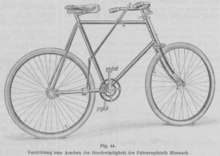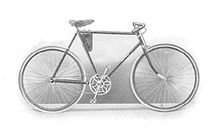Wartburg (bicycle brand)
| Wartburg | |
|---|---|

|
|
| owner | |
| Introductory year | 1896 |
| Products | Cycles |
| Markets | worldwide |
Wartburg bicycles (after 1904 also Dixi-Wartburg) was a bicycle brand of the vehicle factory Eisenach AG - from 1904 also called Dixi -Werke, or from 1921 "Fahrzeugfabrik Eisenach, branch of Gothaer Waggonfabrik AG ".
Brand history
Shortly after the founding of the Eisenach vehicle factory by the industrialist and inventor Heinrich Ehrhardt in 1896, the factory began manufacturing various types of bicycles under the brand name “Wartburg”, which was derived from the Wartburg near Eisenach . In 1898 this brand name was also applied to the Wartburg motor vehicles now being produced in the factory .
After economic difficulties from 1903, the departure of the founding Ehrhardt family from the plant in 1904 and the associated loss of the vehicle licenses issued on Erhardt, the company's management decided to introduce the new “ Dixi ” brand for the automobile production branch. "Wartburg" was used as a brand name for bicycles until around 1920 . Only then did " Dixi " become the brand name for the bicycles manufactured in the factory until the end of production in 1929. It is possible that there was also a parallel use of the two brand names for bicycles. The established bicycle brand Wartburg remained as a registered trademark of the plant until 1932. An advertisement from 1920 shows that the manufacturer's racing bikes were advertised as "Dixi-Wartburg".
In the 1920s, the plant had a well-developed dealer network with general agencies in Düsseldorf , Hamburg and Berlin .
Following the takeover of the Eisenach vehicle factory by Bayerische Motorenwerke in 1928 , the plant ceased production of bicycles in 1929.
From around 1934 the brand name "Dixi" was used by Patria - until the 1950s. The brand name Wartburg was referring to 1955 exclusively to the automobile plant in Eisenach made Wartburg cars .
In May 2016, the company "Wartburg Velociped Manufactur", which was being founded, announced that it would again build bicycles with the brand name "Wartburg" from spring 2018. However, these plans were not implemented.
Model range and production figures
Since the establishment of the plant, production has included men's and women's bikes for normal use as well as racing bikes and bicycles for military use. At least the bicycles of the aegis Ehrhardt (1886–1903) offered under the Wartburg brand were characterized by a multitude of technical innovations. One such innovation was the so-called “Bergrad”, which was developed for the army from 1898 onwards, “helping to protect the horses”. The mountain bike worked with a chainless power transmission by means of two bevel gear pairs with long shafts and was equipped with a gear shift and a shift linkage on the middle frame. The frame was additionally reinforced for the special loads of military use. The technology used in mountain biking was also used on chained men's bicycles without gears.
Motorized two-wheelers, whose frames and wheels were clearly based on the bicycle, formed a transition from bicycle to motorcycle in today's sense.
Preserved catalogs from 1910 to 1916 show a range of 10 standard models , which in addition to the men's bike models England bike , half-burner, racing bike and touring bike also included two ladies bike models and children's bikes. A special version for bicycle gymnastics has also been handed down.
The distinguishing feature of most of the Wartburg bicycles was, in addition to the riveted sprocket with six sections and curved struts, the distinctive steering head plate. A banderole with the word "Wartburg" runs across the playful oval. The model number was usually stamped in the lower part of the steering head label. The doorbell lid, on the other hand, was adorned with a sign bearing the outline of the Wartburg . Here, too, the name "Wartburg" was found in ornate letters.
In 1898 35 bicycles were produced daily, the annual production was accordingly about 10,000 pieces. In the 1900/1901 financial year, production came to a complete standstill, but in 1903 it should again be around 15,000 wheels manufactured annually. From 1905 onwards, bicycle production even made up the largest share of the factory's profits. During this period, the number of employees in bicycle production was around 500 and thus around half of the total number of around 1120 workers. By 1910, the vehicle factory had produced a total of 100,000 wheels, making it one of the larger manufacturers in Germany.
The price per bicycle was 290 marks in 1899. With an average annual income of 834 marks, a “Wartburg bike” cost around a third of the annual income of a simple worker.
There appears to have been no other notable changes to the products during the 1920s. The well-known illustrations and the few surviving copies show that the shape of the bicycles has remained unchanged for almost 20 years.
See also
Web links
- Wartburg Signals - Wartburg-Signale.de accessed on November 3, 2014
- Dixi Magazin - Dixi-Automobile.de accessed on May 13, 2013
Individual evidence
- ↑ a b c Wartburg bicycles (signals 60-81) | Wartburg signals. In: www.wartburg-signale.de. Retrieved May 8, 2016 .
- ^ Address book for the bicycle, motor vehicle and sewing machine industries in Germany, 1928–1929. Bielefeld: Verlag E. Gundlach, 1928. P. 1285
- ↑ Advertising Dixi Wartburg leads!
- ↑ Erich Eicker: The construction of the German bicycle industry . University of Cologne, Cologne 1929
- ↑ Christian Pierer: The Bayerische Motoren Werke until 1933 - A company founded in war, inflation and the global economic crisis. Munich 2011, p. 205
- ↑ Wartburg bikes shortly before their comeback , May 2, 2016 (press release).
- ↑ bicycles. In: Polytechnisches Journal . 308, 1898, pp. 233-237.



